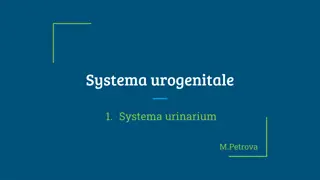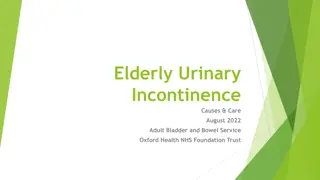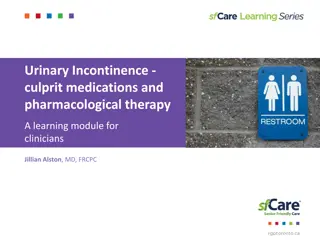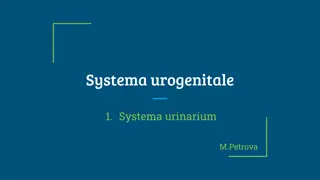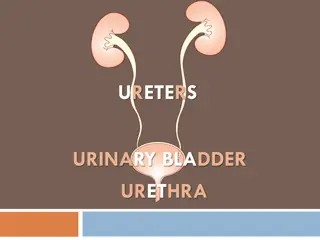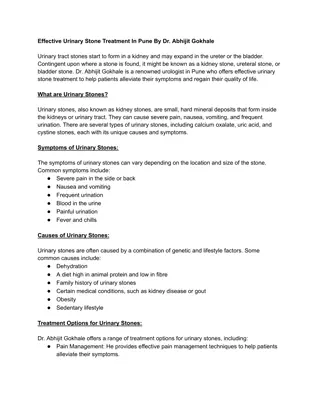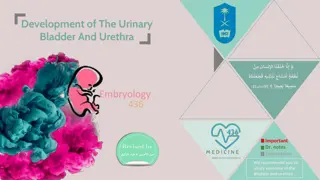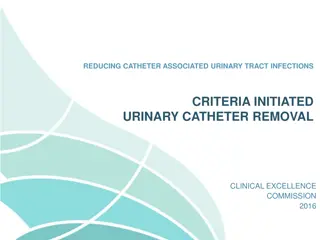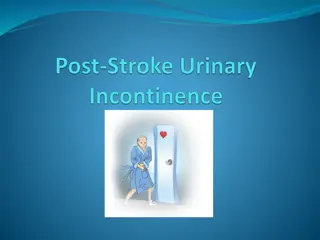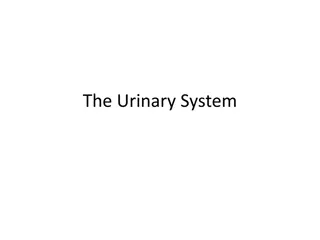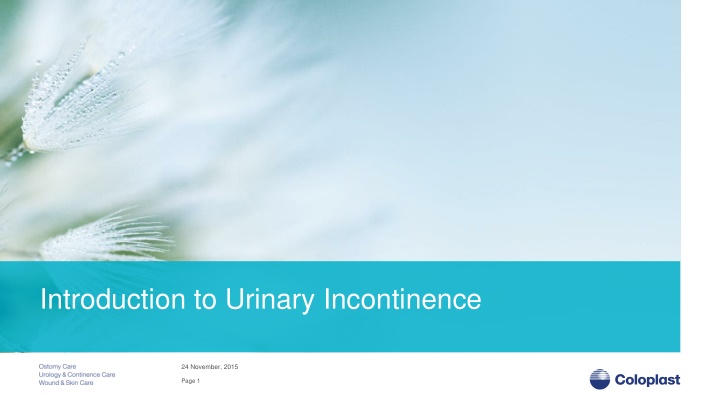
Urinary Incontinence Causes and Impact on Quality of Life
Urinary incontinence, a prevalent disorder, affects individuals physically, psychologically, and socially. Neurogenic and non-neurogenic conditions contribute to this issue, impacting quality of life significantly. The condition is categorized into retention and incontinence, leading to distress, embarrassment, isolation, and loss of independence. Addressing these causes and effects is crucial to providing better care and support for individuals dealing with urinary incontinence.
Download Presentation

Please find below an Image/Link to download the presentation.
The content on the website is provided AS IS for your information and personal use only. It may not be sold, licensed, or shared on other websites without obtaining consent from the author. If you encounter any issues during the download, it is possible that the publisher has removed the file from their server.
You are allowed to download the files provided on this website for personal or commercial use, subject to the condition that they are used lawfully. All files are the property of their respective owners.
The content on the website is provided AS IS for your information and personal use only. It may not be sold, licensed, or shared on other websites without obtaining consent from the author.
E N D
Presentation Transcript
Introduction to Urinary Incontinence 24 November, 2015 Page 1
What is incontinence? The passing of urine in an undesirable place or at inappropriate times twice or more a month regardless of quantity lost. Thomas et al., 1980 Urinary incontinence is a condition in which the involuntary loss of urine is a social and hygienic problem. International Continence Society., 2005 24 November, 2015 Page 2
Incontinence/Retention Causes of Urinary Problems Neurogenic conditions causing urinary incontinence Conditions causing damage to the nervous system include: Spinal cord injury Multiple sclerosis Spina bifida Diabetes mellitus Stroke Non-Neurogenic conditions causing urinary incontinence Weakening of the pelvic floor due to age or childbirth BPH (enlarged prostate) Prostate or bladder surgery Bladder cancer Botox injections of the bladder to manage urinary incontinence Ageing 24 November, 2015 Page 3
Incontinence/Retention Multiple Impact of Urinary Incontinence Physiological Psycological Social ruined clothing and bedding, need for surgery, moisture lesions distress, embarresment, inconvenience, self esteem, loss of control, desire to be normal withdrawal from everyday activity, loss of confidence, avoidance of social activities, strain on personal relationships 24 November, 2015 Page 4
Incontinence has a big impact on peoples lives Urinary incontinence (UI) is a common disorder which has a substantial impact on quality of life (QoL). Perceived as truly debilitating from a physical, psychological and social point of view, it may cause both isolation and loss of independence [...]. - Chartier-Kastler et al., 2010 People are left feeling;- Distressed Embarrassed Isolated Helpless Low self-esteem Loss of personal control Desire for a normal life 24 November, 2015 Page 5
Urinary Incontinence can typically be split in two groups Retention Urinary retention (inability to empty the bladder) Incontinence Urinary incontinence (involuntary leakage of urine) 24 November, 2015 Page 6
Symptoms Typical symptoms of urinary incontinence Urinary leakage Small or large amounts of urine leaking without warning or without feeling the urge to go to the toilet Involuntarily leakage when sneezing, coughing, laughing or exercising A sudden urge to rush to the toilet to urinate The need to get up to pass urine two or more times a night (nocturia) Typical symptoms of urinary retention Discomfort Urgent sense to urinate but inability to start the urine flow Frequent visits to toilet Dribble due to overflow incontinence Weak flow Bloated lower abdomen 24 November, 2015 Page 7
There are many small hints and tips which people find useful to follow in order to reduce symptoms Drink plenty of fluid eg.3-4 pints a day, do not restrict intake Water is best alcohol, caffeinated and carbonated drinks can increase symptoms which indicate bladder irritation Concentrated urine is more irritable to the bladder than diluted Avoid constipation by eating a healthy, balanced diet (constipation can affect the urinary system as well) Try and hold onto the urine in a little longer if you experience urgency Pelvic-floor / Kegel exercises If a patient continues to experience problems, they should speak to their healthcare professional and ask for further assistance 24 November, 2015 Page 8
Male and female (>40 years) community prevalence of lower urinary tract symptoms (LUTS) Chart Title Female (N=3760) None or mild Moderate Severe None or mild Severe Moderate 3% 16 % 16% 4% 81% Boyle P et al. BJU 2003 24 November, 2015 Page 9
Retention Urinary Retention Urinary retention can be caused by an obstruction in the urinary tract, a bladder muscle weakness or by a neurogenic condition e.g. multiple sclerosis, spinal cord injury or spina bifida all of which interfere with signals between the brain and the bladder, resulting in a dysfunction in the urinary system. 24 November, 2015 Page 10
Urinary Incontinence Stress urinary incontinence (SUI) occurs when the muscles in the pelvic floor, under sudden, increased pressure (stress), are too weak to hold the urethral sphincters closed. The result is an involuntary leakage of urine during everyday activities such as sneezing, coughing, laughing or exercising. Women: Pregnancy, childbirth and menopause Men: Removal of prostate gland . Urge urinary incontinence (unstable or overactive bladder) is caused by involuntary, uncontrolled contractions of the muscle in the bladder. This results in a sudden urge to go to the toilet, and involuntary urine leakage before reaching the toilet. UTI, neurological disorder Mixed urinary incontinence is a combination of stress urinary incontinence and urge urinary incontinence. Overflow incontinence (a frequent or constant dribble of urine) results from an inability to empty the bladder. With overflow incontinence you may feel as if you never completely empty your bladder. When you try to urinate, you may produce only a weak stream of urine damaged bladder, blocked urethra or neurological damage 24 November, 2015 Page 11
Common causes of non-neurogenic lower urinary tract symptoms Enlarged prostate Urinary retention Surgeries in urinary tract (bladder and prostate) Mainly stress incontinence Aging All types of incontinence Incapability to fully empty the bladder Child birth Stress incontinence 24 November, 2015 Page 12


